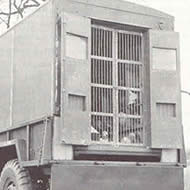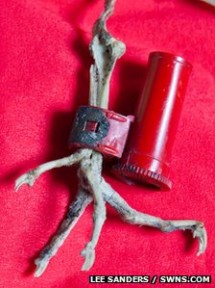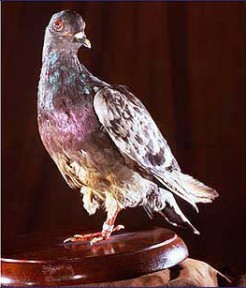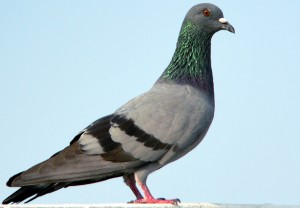
Pigeons played an exceptional role in WWI and WWII. Pigeons were able to fly over enemy lines to send messages to allies all over the continent without the risk of having planes shot down or vehicles destroyed trying to relay that same message. Although many pigeons were killed in the process of transferring these messages, their success was great enough to merit the establishment of the Pigeon Corps in 1915. This group started with 15 mobile pigeon stations, or pigeon wagons, each with 4 birds and a handler and grew in size to over 400 men and 22,000 pigeons by the end of the war.

Pigeons had a small canister attached to their legs that allowed for a message to be inserted and transported back to command posts. This system proved to be the most effective means of transporting important messages as pigeons are incredibly fast fliers and the telegraph system that existed during the war was still not very efficient. Many of these pigeons carried messages that saved the lives of many soldiers, and as a result, were awarded medals for heroism and service to their respective countries. One pigeon named ‘Red Cock’ carried a message that contained the coordinates of a sinking boat that had been torpedoed back to its loft at the command post which allowed a rescue team to be dispatched in time to save the crew. For his services, ‘Red Cock’ was awarded the Dickin Medal for his bravery. (3) This medal is the animal equivalent of the Victoria Cross which is awarded to individuals “for most conspicuous bravery, or some daring or pre-eminent act of valour or self-sacrifice, or extreme devotion to duty in the presence of the enemy.”(10)
As a result, the Dickin Medal is the highest honor that an animal can be awarded for military service, and of the 55 Dickin Medals awarded to animals, 32 of them were awarded to pigeons. Another pigeon named ‘Cher Ami’ had an even more fascinating story. In 1918, 500 allied soldiers were trapped with no food or ammunition in France and were being bombarded by friendly fire. Many men were being killed and there seemed to be no hope of surviving the attack. As a last ditch effort a message was attached to a pigeon which was released and immediately shot down by the enemy. A second pigeon was released with a message and a suffered a similar fate. The final pigeon, ‘Cher Ami’ was then called for. As with the first two birds, a message was attached to its leg and it was released into the sky. ‘Cher Ami’ was instantly shot through the breast and fell to the ground; however, unlike his predecessors, ‘Cher Ami’ got back up and continued to fly another 25 miles, amidst a sky of bullets and the chaos of war, all the way back to headquarters. He delivered the message and was able to save the 194 remaining soldiers from certain death; however, his wounds consisted of a shot through the breast, a blinded eye and a nearly unattached leg. Miraculously, medics were able to save the bird and replaced his wounded leg with a wooden one. For his services, ‘Cher Ami’ was awarded the Croix de Guerre Medal, inducted into the racing pigeon hall of fame, and became the mascot of the Department of Service. (3)

Pigeons continued to be of great service during the Second World War. All fighter pilots carried two pigeons with them during missions so that if their planes were shot down they could send word of their coordinates to be rescued. Multiple pigeons were awarded medals for doing just this throughout the World War II. Additionally, special crates containing pigeons, enough food for 10 days, and directions for use were dropped in enemy occupied territories throughout Europe in hopes that allies would find them and send word of enemy positions and movements. Although many of the birds did not return, those that did brought with them information that unquestionably helped in the war effort and eventual victory. Pigeons, despite their proficiency at message delivery, were also used to take aerial photos of enemy encampments by means of an ingenious harness that allowed for a camera to be mounted on the underside of the birds without hampering their ability to fly. The birds were flown over suspected enemy positions and upon their return, the film was developed resulting in valuable information on the enemy. The impact of the pigeon on the war effort during both World Wars cannot be overstated. Hundreds of thousands of pigeons gave their lives for their countries, and in doing so saved the lives of countless soldiers and turned the tide of the war. (3)

A poem by Harry Webb Farrington commemorating the heroic actions of Cher Ami, or in French, ‘dear friend’.
Cher Ami
Cher Ami, how do you do!
Listen, let me talk to you;
I’ll not hurt you, don’t you see?
Come a little close to me.
Little scrawny blue and white
Messenger for men who fight,
Tell me of the deep, red scar,
There, just where no feathers are.
What about your poor left leg?
Tell me, Cher Ami, I beg.
Boys and girls are at a loss,
How you won that Silver Cross.
“The finest fun that came to me
Was when I went with Whittlesey;
We marched so fast, so far ahead!
‘We all are lost,’ the keeper said;
‘Mon Cher Ami–that’s my dear friend–
You are the one we’ll have to send;
The whole battalion now is lost,
And you must win at any cost.’
So with the message tied on tight;
I flew up straight with all my might,
Before I got up high enough,
Those watchfull guns began to puff.
Machine-gun bullets came like rain,
You’d think I was an aeroplane;
And when I started to the rear,
My! the shot was coming near!
But on I flew, straight as a bee;
The wind could not catch up with me,
Until I dropped out of the air,
Into our own men’s camp, so there!”
But, Cher Ami, upon my word,
You modest, modest little bird;
Now don’t you know that you forgot?
Tell how your breast and leg were shot.
“Oh, yes, the day we crossed the Meuse,
I flew to Rampont with the news;
Again the bullets came like hail,
I thought for sure that I should fail.
The bullets buzzed by like a bee,
So close, it almost frightened me;
One struck the feathers of this sail,
Another went right through my tail.
But when I got back to the rear,
I found they hit me, here and here;
But that is nothing, never mind;
Old Poilu, there is nearly blind.
I only care for what they said,
For when they saw the way I bled,
And found in front a swollen lump,
The message hanging from this stump;
The French and Mine said, ‘Tres bien,’
Or ‘Very good’–American.
‘Mon Cher Ami, you brought good news;
Our Army’s gone across the Meuse!
You surely had a lucky call!
And so I’m glad. I guess that’s all.
I’ll sit, so pardon me, I beg;
It’s hard a-standing on one leg!”
2 Comments
Leave a Reply
You must be logged in to post a comment.

26 Jan ’14 @ 2:38 am
What a wonderful story, I only heard about the pigeons on a TV programme today (26.1.14) – 100 years after these wonderful birds were flying. Very goose-bumpy story. It is so good that they have been recognised with their own medals and place of importance during the wars.
9 Feb ’14 @ 8:29 am
I recently received a very moving email from my sister about a similar pidgeon. I am an absolute animal lover, and unlike many people today I love the pidgeons. As an archetype they represent home and family. Indeed, in their heroic work during these wars they were assisting in keeping families together by saving lives. How beautiful to see animals receive medals of honor!!